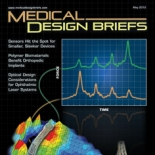A young engineer recently recounted that his Senior Design professor would frequently repeat this mantra: “A good engineer designs to spec, to budget, and to deadline.”
Therefore, it came as little surprise when a recent survey of medical device design engineers, conducted in April 2011 by medical device media company UBM Canon, revealed accuracy and cost as the two key attributes they seek in a force sensor when designing a new product. A follow-up question asked participants about the greatest challenges they face in sourcing sensor technologies. Cost and ease of integration topped the list.
What does this mean for engineers seeking an accurate, cost-effective, customizable force sensor? Perhaps the most well known transducers for measuring force are load cells. They can use a variety of technologies to sense loads. Strain gauges, piezoelectric elements, and variable capacitance are among the methods in wide use.
Load cells, while known for high precision, have some drawbacks, particularly in applications where weight, size, and/or power are at a premium. Load cells can be bulky. In situations where the application of interest involves relatively lightweight elements, a load cell may actually weigh more than the component being tested. Load cells can also be expensive, in terms of piece-price as well as integration. Another disadvantage of using a load cell is that, rather than providing direct force measurements, they measure the correlating strain of an assembly based on the applied load. This adds complexity to the setup.
In recent years, tactile force sensors have become commercially available. The term comes from their frequent use as a means of sensing a nuanced or delicate touch, as with a robotic hand from a humanoid robot. However, tactile sensors have applications extending far beyond anthropomorphic robots. They typically are built on flexible circuit material so they can be thin, light, and flexible.
One such tactile sensor is designed for applications requiring unobtrusive, cost-effective force measurement. The FlexiForce™ sensor, manufactured by Tekscan, Inc. (Boston, MA), consists of piezoresistive material sandwiched between two pieces of flexible polyester with printed-silver conductors on each inner half. The conductive traces form electrical connections to external circuits (Fig. 1). The resulting sensor is only about 8 mils thick. The sensor is also very light; an 8-inch length sensor weighs 0.02 oz.
To read the full article, please click here:
http://www.medicaldesignbriefs.com/component/content/article/13606
